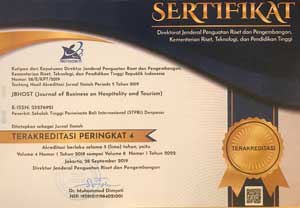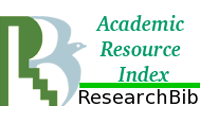Analysis of Tirta Empul Development Strategy as Wellness Tourist Attraction in New Normal Era
Abstract
The Covid-19 pandemic is a very dangerous epidemic that affects the order of human lives around the world. The existence of the Covid-19 pandemic has made everyone without exception have to be able to adapt to the new life order or new normal era in accordance with health protocols. In this new normal era, many people have begun to take short, cost-effective trips and tend to seek pleasure and health simultaneously to reduce boredom and stress when forced to stay at home during lockdowns. One of the tourism trends that is coming back is Wellness Tourism. The current trend of Wellness Tourism is one of the options for restoring the passion of tourism in Bali Province which will encourage public interest in travelling. Tirta Empul is one of the tourist attractions that have the potential to support wellness tourism as a Wellness Tourist Attraction. This research was conducted in Tirta Empul which aims to analyze development strategies related to the wellness tourist attraction. This study uses data processing analysis carried out by SWOT through an analysis process of internal factors (IFAS) and external factors (EFAS). The results showed that the Grand Strategy obtained in this study is the S (Strength) - O (Opportunity) Strategy, so that there are opportunities to develop Tirta Empul as a Wellness Tourist Attraction in a New Normal Era.
Keywords
Full Text:
PDFReferences
Arikunto. (2013). Research Procedure: A Practical Approach. Jakarta: Rineka Cipta.
Global Wellness Institue. (2021). What is Wellness Tourism. Retrieved February 15, 2021, from Global Wellness Institue website: https://globalwellnessinstitute.org/what-is-wellness/what-is-wellness-tourism/
Meikassandra, P., Prabawa, I. W. S. W., & Mertha, I. W. (2020). Wellness Tourism In Ubud. "A Qualitative Approach To Study The Aspects Of Wellness Tourism Development. Journal of Business on Hospitality and Tourism, 6(1).
Ministry of Education and Culture. (2019). Factors Driving the Utilization of the Tirta Empul Temple Site. Retrieved February 15, 2021, from kebultur.kemdikbud.go.id website: https://kebultur.kemdikbud.go.id/bpcbbali/faktor-faktor-pendorong-pemanektronik-situs-pura-tirta-empul/
Ministry of Tourism and Creative Economy. (2020). Care Covid 19. Retrieved February 15, 2021, from pedulicovid19.kemenparekraf.go.id website: https://pedulicovid19.kemenparekraf.go.id/pATIS-protokol-kkes-bali-safari-dan-tirta-empul-siap-dibuka/
Nusa Bali. (2017). Bali Wins Spa Destination Award. Retrieved February 24, 2021, from Nusa Bali website: https://www.nusabali.com/berita/20967/bali-raih-pengharga-destinasi-spa
Rahyuda, I. (2014). Ritual Bathing: Melukat Purification Tradition as SPA Attractions and Tourist Destinations (I. Setiawan, Ed.). Denpasar: Pustaka Larasan.
Rangkuti, F. (2006). Swot Analysis Techniques Dissecting Business Cases. Jakarta: PT Gramedia Pustaka Utama.
Rokom. (2021). Status Wabah Corona di Indonesia Ditetapkan sebagai Bencana Nasional. Retrieved January 19, 2021, from Sehat Negeriku Sehatlah Bangsaku website: https://sehatnegeriku.kemkes.go.id/baca/rilis-media/20200315/3633379/status-wabah-corona-indonesia-ditetapkan-bencana-nasional/
Ross, K. (2001). Health Tourism: An Overview By Kim Ross (HSMAI Marketing Review). Retrieved February 12, 2021, from hospitalitynet.org website: https://www.hospitalitynet.org/news/4010521.html
Soeprato, E. D., & Hindarwati, N. (2013). Business Strategy Analysis in Sekarguna Medika. Universitas Bina Nusantara.
Sugiyono. (2015). Metode Penelitian Kuantitatif, Kualitatif, dan Kombinasi (Mixed Methods) (8th ed.). Bandung: Alfabeta.
Sugiyono. (2020). Tourism Research Methods (1st ed.; N. Yuniati, Ed.). Bandung: Alfabeta Publisher.
Sutrisna, I. K. A. (2009). Bali Receives the Best Spa Destination Award. Retrieved from BeritaBali.com website: https://www.wisata.beritabali.com/read/2009/03/24/200903240007/bali-terima-pengharga-destinasi-spa-terbaik
DOI: http://dx.doi.org/10.22334/jbhost.v7i1.279
Refbacks

This work is licensed under a Creative Commons Attribution 4.0 International License.
Visited Number:






















